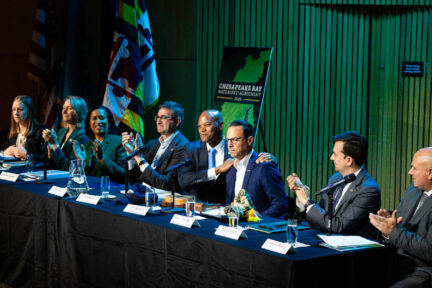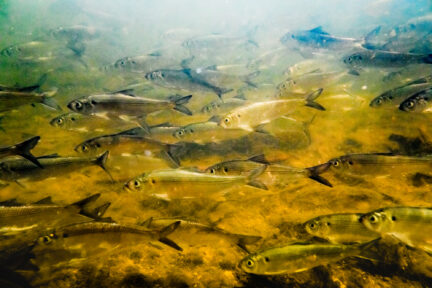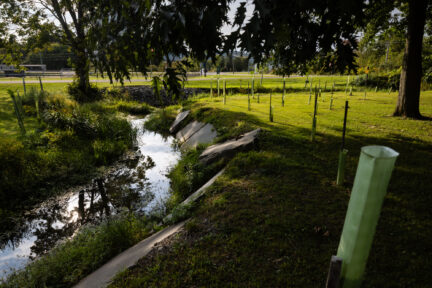Eighteen New Public Access Sites Created in Chesapeake Region in 2012
Eighteen New Public Access Sites Created in Chesapeake Region in 2012
In 2012, Chesapeake Bay Program partners added eighteen new public access locations along the region’s waterways for public use and enjoyment, bringing the total number to 1,171 across the watershed. In four states – Maryland, Pennsylvania, New York and Virginia – multiple partners created locations where people can reach local rivers, streams and the Chesapeake Bay, whether for fishing, boating or other enjoyment.
Collaborative work to improve public access in the Chesapeake watershed is coordinated by the National Park Service and CBP’s Public Access Planning Action Team which includes staff from six states and the District of Columbia. The team developed a Chesapeake Bay Watershed Public Access Plan designed to assess the demand for access; describe the existing public access facilities; assess barriers to access; determine gaps in the public access system; identify opportunities for new sites; and help direct federal, state, and local funding toward access opportunities.
Public access goals set through the Strategy for Protecting and Restoring the Chesapeake Bay Watershed, the federal response to President Obama’s Executive Order 13508, called for adding 300 new sites where citizens can have a waterside experience, whether hiking, paddling, swimming, or fishing. These eighteen new public access sites count towards meeting the goal of 300 new sites by 2025. To be counted as new access, a site must be meet specific criteria related to location, ownership, and various kinds of recreational uses.
The public can view the interactive mapping tool created and used by the Action Team to track public access locations. A free mobile application, Chesapeake Explorer, helps people find locations and activities for recreation around the Chesapeake watershed.
Facts
| Site | Water Body | County | Description |
|---|---|---|---|
| Wooten's Landing | Patuxent River | Anne Arundel | Soft launch |
| Nan's Cove | Nan's Cove | Calvert | Soft launch, fishing access nearby |
| Blackwater National Wildlife Refuge | Chesapeake Bay | Dorchester | New overlook boardwalk |
| Manokin Kayak & Canoe Launch | Manokin River | Somerset | Soft launch, fishing access |
| Site | Water Body | County | Description |
|---|---|---|---|
| Compton Bridge FAS | Susquehanna River | Otsego | Hand launch, cartop boat access, 4-6 cars no trailers |
| Greenough FAS | Oaks Creek | Otsego | Hand launch, cartop boat carry in access, 2-3 cars no trailers |
| Lake Goodyear water access | Lake Goodyear | Otsego | Hand launch, cartop boat access with staircase, 10 cars |
| Portlandville FAS | Susquehanna River | Otsego | Improvements by DOT in Aug. 2012 |
| Site | Water Body | County | Description |
|---|---|---|---|
| North Bend Access | Susquehanna River | Clinton | Boat launch and parking |
| Fishing Creek Sportmen Assoc. Easement | Fishing Creek | Columbia | Walk-in public fishing access and conservation easement |
| Little Juniata | Little Juniata River | Huntingdon | Walk-in public fishing access and conservation easement |
| Norfolk Southern Acquisition | Susquehanna River | Lancaster | New viewing access to the Susquehanna River |
| Site | Water Body | County | Description |
|---|---|---|---|
| Alpine | James River | Botetourt | Hand-carry boat launch and parking |
| Lawrence Lewis, Jr. Park | James River | Charles City | Access to park beach for fishing and wading |
| Eco-Discovery Park | James River | James City | Hand-launch boat access |
| RRNWR Laurel Grove | Farnham Creek | Richmond | Wildlife observation trail |
| Strasburg Landing | Shenandoah River | Shenandoah | Hand-launch boat access |
| Hunting Run | Rapidan River | Spotsylvania | Hand-launch boat access |
Issues
Despite having more than 1,100 existing sites in the region, physical access to the Chesapeake and its many rivers, creeks and streams and lands surrounding them remains limited. The goal is to add 300 new public access sites by 2025 although many challenges remain.
Importance
Open, green spaces and waterways with ample public access bolster public health and quality of life. People rely on these special places to exercise, relax, and recharge their spirits. Outdoor time strengthens family bonds and nurtures fit, creative children. At the same time, it builds personal connections with the very places that have shaped life in the region for centuries—especially its streams, rivers, and bays. Public access to natural areas also has a distinct economic value as tourism, much of which is associated with the area’s waters, and is a potent force in the region.
The sense of place that evolves from outdoor experiences along Chesapeake waters often leads to a feeling of shared responsibility for the resources. People who enjoy the outdoors are more likely to become active citizen stewards, engaged in the many conservation and stewardship efforts taking place throughout the region.
Quotes
“Our state partners report that citizens demand additional access to waterfront experiences. They want more places close to home where they can walk, play in the water, fish, paddle, and launch a boat. And residents and our partners are excited about increasing the number of those places, because it also increases our quality of life."
--Jonathan Doherty, Acting Superintendent, National Park Service Chesapeake Bay Office
“The waters across the Bay region can serve a variety of recreational, economic, and environmental purposes and all of them are vital to a healthy Bay system for everything and everyone that lives here. But they can only serve us well if we value and protect them.”
--Nick DiPasquale, Director, Chesapeake Bay Program (EPA)



